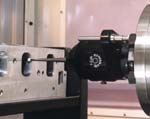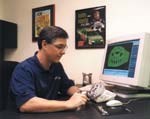Racing Team Shifts Into Reverse Engineering
When the Joe Gibbs Racing team went shopping for a reverse engineering system five years ago, it looked at a variety of technologies. But the team decided to put this on-machine scanning system in the driver's seat of its reverse engineering program.
Share




The Joe Gibbs Racing (Huntersville, North Carolina) operation is miles ahead of yesteryear's race garage in terms of size, capabilities and technology. Gibbs currently employs 120 in a 145,000-square-foot facility, which includes separate departments for CNC machining, engine design/build, body and paint, and equipment transport. The team has access to a wide variety of CAD/CAM computer software packages as well as a flow bench simulator to test CAD port designs before cutting prototypes.
The CNC department is stocked with eight machines churning out a wide variety of critical car components. But because cylinder heads have such a pronounced effect on engine efficiency and performance, they are one of the most vital components the department produces.
In simplest terms, engines behave as air pumps. As an engine's flow capabilities increase, so does its power potential. Cloned, machined ports flow evenly with limited "bad" turbulence, allowing the engine to breathe easier and perform better. Gibbs' Winston Cup engines pick up an estimated 200 horsepower after port modifications to the far-from-race-ready aluminum heads the team receives from GM.
But there is no single perfect port design—or engine combination—best suited for every race. For example, high torque is required on short tracks, while overall horsepower is the name of the game on superspeedways. Engine builders must adjust for "plate" races, as well, in which restrictor plates are installed between carburetor and manifold to limit flow and reduce power. Just like any other engine component, ports must be engineered to match the desired power curve for each race.
Heads must comply with NASCAR restrictions on maximum port volume, though. Top-finishing cars are torn down and inspected by NASCAR officials after every race. Violations uncovered during these post-race inspections can cost teams fines or even victories. Duplicating ports known to be within specification ensures every port will meet regulations.
Gibbs engineers develop port models both through hand grinding and CAD. Results from flow bench testing of physical prototypes determine which intake/exhaust ports and combustion chamber profiles are scanned. Original port designs are often re-worked then re-tested on the flow bench numerous times to generate best flow numbers out of the head. "The slightest modification to CAD-designed profiles renders the original CAD file useless and requires scanning to capture the new profile," says Mark Bringle, CNC manager. "And even though hand porting may yield a good single profile, it's impossible to replicate that design for all eight cylinders without scanning.
When the Gibbs team went shopping for a reverse engineering system five years ago, it looked at a variety of technologies. But the team decided to put the Renishaw (Hoffman Estates, Illinois) Renscan 200 on-machine scanning system in the driver's seat of its reverse engineering program.
"Still a relatively new team, we wanted a cost-effective, yet accurate scanning system that would take minimal ramp-up to start producing finished heads," says Mr. Bringle.
The on-machine system with Tracecut software allows the team to duplicate ideal port and combustion chamber designs and generate NC code necessary to machine those critical profiles into its aluminum heads. Smooth, identical head ports are essential to enable Gibbs' engines to reach their maximum power potential.
Having prior experience with CMMs, Mr. Bringle was initially skeptical. "It took some time to find the correct head fixture angles," says Mr. Bringle, "but once machined, you can't see or feel where the cuts cross over. The machine tool cuts exactly what the probe scans."
The system generated finished heads after only one month of purchase. "We heard horror stories that it would take six months to get all the technology together, but we had finished heads using the Renscan within a month," says Mr. Bringle. "In fact, the first set of heads from the system won the fall Atlanta race in 1997."
Despite recent successes, the team doesn't plan to rest on its laurels or its R&D efforts, and the Renscan 200 will continue to play a big role. "The affordable system performs well for us and would perform well for anyone who needs a reverse engineering system but doesn't want to shell out $200,000 for a CMM," Mr. Bringle says.
Related Content
Continuous Improvement and New Functionality Are the Name of the Game
Mastercam 2025 incorporates big advancements and small — all based on customer feedback and the company’s commitment to keeping its signature product best in class.
Read MoreCan ChatGPT Create Usable G-Code Programs?
Since its debut in late 2022, ChatGPT has been used in many situations, from writing stories to writing code, including G-code. But is it useful to shops? We asked a CAM expert for his thoughts.
Read MoreThe Power of Practical Demonstrations and Projects
Practical work has served Bridgerland Technical College both in preparing its current students for manufacturing jobs and in appealing to new generations of potential machinists.
Read MoreGenerating a Digital Twin in the CNC
New control technology captures critical data about a machining process and uses it to create a 3D graphical representation of the finished workpiece. This new type of digital twin helps relate machining results to machine performance, leading to better decisions on the shop floor.
Read MoreRead Next
Building Out a Foundation for Student Machinists
Autodesk and Haas have teamed up to produce an introductory course for students that covers the basics of CAD, CAM and CNC while providing them with a portfolio part.
Read MoreRegistration Now Open for the Precision Machining Technology Show (PMTS) 2025
The precision machining industry’s premier event returns to Cleveland, OH, April 1-3.
Read More5 Rules of Thumb for Buying CNC Machine Tools
Use these tips to carefully plan your machine tool purchases and to avoid regretting your decision later.
Read More
























.jpg;maxWidth=300;quality=90)












